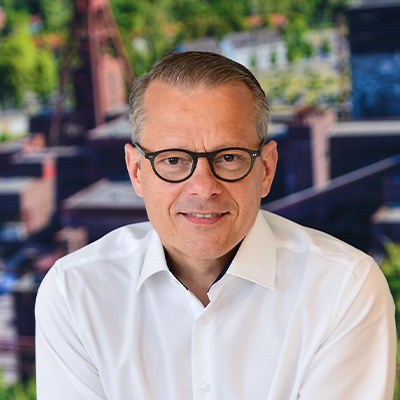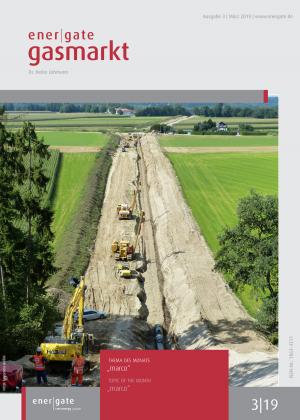In June last year, the power transmission system operator Amprion and Open Grid Europe introduced their “idea” for a 100 MW electrolyser (ener|gate Gasmarkt 07/19). In the meantime, the idea has become a project, as Amprion Technology Managing Director Klaus Kleinekorte and Thomas Hüwener, responsible for technology in the OGE management board,described at a press conference in Berlin in February. Both explained the new status in a press meeting in February in Berlin. What does that mean exactly? Two project managers were appointed (one from Amprion, one from OGE) and a project name – Hybridge – was chosen. A location was chosen (Lingen in the southern Lower Saxony in the Ems region, Figure 10) and a first utilisation concept was made. The focus will clearly be on the utilisation of hydrogen for industries. OGE will convert a pipeline from gas to hydrogen (the green line in Figure 10). Close to the pipeline salt caverns used for gas storage (Epe) might be converted to hydrogen, but at a later stage. The pipeline might even be extended. Smaller volumes of hydrogen are to be injected into the gas network. And on small scale, processing the hydrogen to methane (CO2 and CH4 in Figure 10) is planned. What is missing?
Stay up to date with the free Gasmarkt-Newsletter! We will inform you about new issues by e-mail and give you an insight into the contents.
- All Issues
- energate Gasmarkt
- Issue 03|19
- Issue title:
"marco"
- Publication date:
- 07.03.2019
- In this issue:
The workshop of the TSOs regarding the market area merger is the topic of the month. I moderated the workshop but that does not mean that I cannot report independently. At the end of the workshop, I praised the TSOs for their presentation of the capacity model. Of course, the TSOs’ presentation did not answer all questions. Some participants even had more questions than answers after the event. But what was important for me, is that these questions are now possible and the further debate is opened. This was more than necessary. As a side note: The report will also be about FZK, bFZK, TaK and DZK. In the story, I have refrained from explaining these terms and hope that you, dear readers, are frequent readers of this publication and familiar with the abbreviations. But for rookies, I am willing to produce a glossary on request.
The Commission “Growth, Structural Change and Employment” (often dubbed “Coal Commission”) presented its final report in January. Whether the phasing out of coal based on the measures proposed by the commission will be too expensive is a societal question. Around at least 80 billion euros (there is no detailed calculation) will be spent for measures to improve the regional structure in lignite regions as well as for the compensation of coal-fired power plant operators and power users. It remains to be seen whether all proposals are transposed into legally binding measures. There are still a number of open questions and conflicts within the governing coalition about the transposition are already becoming visible.
Sales Contact

Frequently Asked Questions
1. What is the energate Gasmarkt?
The energate Gasmarkt provides specialists and executives in the gas industry with up-to-date information and background information on the German and international gas market. The medium expertly explains the most important developments in the fields of market, law, politics and business. In addition, the energate Gasmarkt offers insider information such as market rumors and personal details.
2. What is the energate Jahresreport Gas?
The energate Jahresreport Gas traces the most important market developments of the year and provides a well-founded outlook for the coming months. Gas expert and insider Dr. Heiko Lohmann analyzes relevant events in politics, law and regulation as well as on generation, infrastructure and trade. In addition, the report provides information on changes in the corporate landscape and tracks price developments in market reports. Top decision-makers from the industry use the Jahresreport Gas as a compact chronicle of the year and to assess future market developments.
3. How often are these publications released and in which formats are they available?
The energate Gasmarkt is published monthly. Subscribers will receive the energate Gasmarkt as a print and PDF version in German and English. The Jahresreport Gas is published annually (beginning of December).
4. Can I purchase individual issues of the energate Gasmarkt?
Yes, you can purchase individual isses as print or PDF version. Payment options include purchase on account, credit card or PayPal.
5. How much is a subscription of the energate Gasmarkt and how much does the Jahresreport cost?
A subscription to the energate Gasmarkt (single licence) costs 110,- Euro/month (plus VAT). An edition of the Jahresreport Gas costs regularly 390,- euro (plus VAT).
6. Are there any special conditions if several employees in a company would like to receive the Gasmarkt?
With several Gasmarkt recipients in one company, the price of the second and all other licenses is reduced significantly. We are happy to make you a fair offer for team or corporate licenses!
7. What benefits do I get by registering?
A free energate account is required to order the energate Gasmarkt or the energate Jahresreport Gas. Registered users receive an overview of the contents of the current issue of energate Gasmarkt by e-mail on the day of publication.
8. I would like to read energate Gasmarkt or energate Jahresreport Gas digitally. Where can I find my e-paper version?
As a subscriber to energate Gasmarkt or as a purchaser of energate Jahresreport Gas, you will also receive an e-paper version in addition to the print edition. You can find it at online.energate-gasmarkt.de. Please use your energate account to log in.


